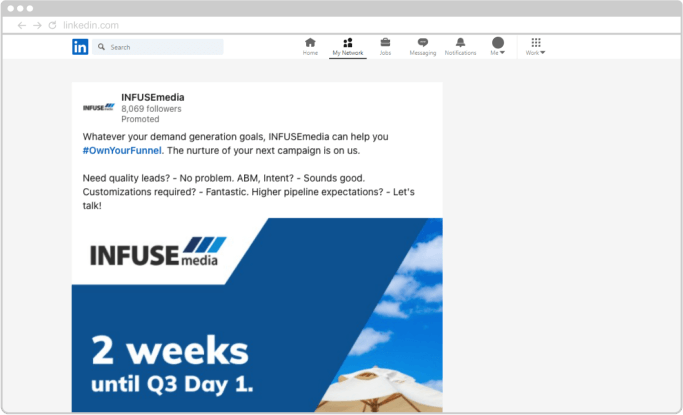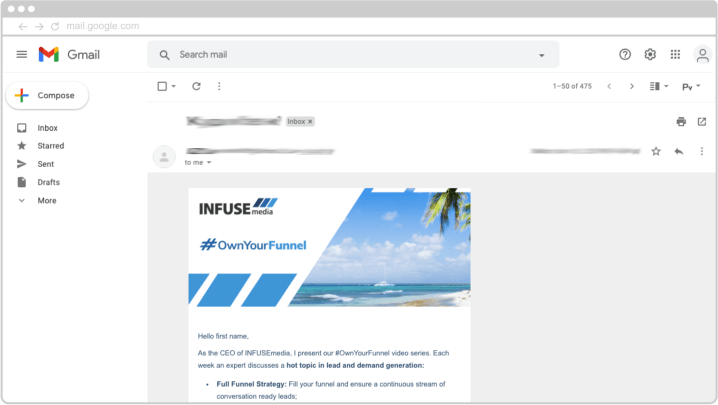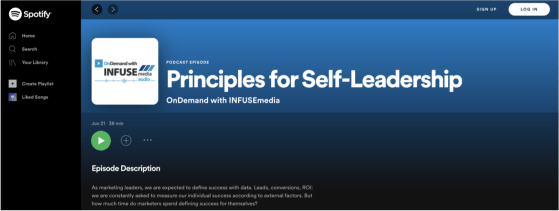Definitive Guide
to Account
Based Marketing
Introduction
Account based marketing (ABM), first coined by ITSMA in 2004, is a marketing approach designed for a specific account or group of accounts.
Unlike traditional marketing it targets a potential client or company, rather than an audience, and thus conversion rates are higher due to the personalization of ads and content.
In the past decade ABM has grown as a key strategy for B2B enterprises, focusing their efforts (and even whole marketing teams) to gain a single account for their portfolio.
But what is ABM and how does it work? This INFUSE guide will define the concept, show you how to create an ABM strategy from scratch, explain the three pillars of ABM tactics, and more.
What is Account Based Marketing?
The definition of account based marketing is a campaign developed with a single or specific group of accounts in mind.
Instead of being an audience-centric approach, ABM is more client-centric with marketing and sales teams combining to win a specific account for the company.
This account (or group of accounts) is usually aligned with the company's Ideal Client Profile (ICP) and the campaigns targeting them are typically personalized to resonate best with their unique pain points and start a conversation with their buying committee. This is why ABM is a preferred method for many B2B marketers, as it is easier to prove ROI and engage prospects when campaigns are designed with a specific list of accounts in mind.
Imagine, for example, a cloud IT company wishes to gain a local university as an account. In this case, marketers and sales development representatives (SDRs) would book a meeting, create marketing materials, launch ads, and make a personalized sales pitch.
Because efforts are focused on a specific client rather than a wider, general audience, the conversion rate is higher which helps to offset the greater effort account based marketing requires. However, it is worth remembering that the cost per lead can be higher due to the single nature of ABM campaigns.
In short, account based marketing is a personalized campaign that targets an account aligned with a brand's ICP in order to maximize the conversion rate and ROI. Its success depends on the alignment of sales and marketing teams, as both need to collaborate to make convincing assets and pitches to the buying committee.
ABM exists across various sectors:
ABM is popular with B2B marketers because in this market sealing the deal with a high-profile account can generate a six-figure addition, or more, for the company coffers.
Those clients recruited via a B2B account based marketing campaign also tend to be more loyal to the brand and more willing to invest in upsells, compared to accounts gained by regular inbound or outbound marketing efforts.
In the B2B world, ABM is the most effective way to secure the highest value accounts. Also, 2021 is set to be a breakthrough year for this marketing method.
How to Launch an Account Based Marketing Strategy in 6 Steps
Despite their proliferation, very few guides to ABM provide a clear roadmap for success in B2B marketing.
This is because a blanket solution for a personalized approach like those used in ABM is contradictory. Even so, it is possible to create a step-by-step process to assist the roles of both marketing and sales teams.
The following account based marketing strategy is based on a one-to-one basis. There are other methods, such as one-to-few, which will be covered later in this guide.
1. Define your Ideal Client Profile (ICP)
Before diving into an actual ABM campaign companies should firstly develop an ideal client profile (ICP).
Gartner defines an ICP thus:
The firmographic, environmental and behavioral attributes of accounts that are expected to become a company’s most valuable customers. It is developed through both qualitative and quantitative analyses and may optionally be informed by predictive analytics software.”
Since ABM is a highly personalized and targeted approach, it makes sense to go after the highest-converting accounts in the marketplace. The initial challenge to any account based marketing strategy therefore will be to develop an ICP that aligns with the direction of the business.
2. Research the Accounts
This might be an obvious step, but it is one that is often overlooked by some marketers and SDRs. Essentially, before contacting an account it is important to have done your homework.
This includes using more regular data analysis techniques like firmographics, technographics and so on, but also in-depth research with psychographics, phone interviews, and if possible, a face-to-face meeting.
Do not be afraid to offer incentives to sweeten the deal, such as gift cards or discounts for those managers that agree to a sales meeting. Most will not mind at all.
Once this data has been compiled, make it presentable in a slideshow, list or infographic for the marketing and sales teams. Then, book a meeting to discuss the data. This meeting will be the arena in which businesses plan for the next step of the campaign.
3. Plan the Content and Delivery
Armed with data, marketing teams will need to decide how to attract and enchant the target account. Generating awareness of your brand, and how it can provide solutions to their problems, is the main objective at this stage.
And personalization is key. If content is custom-tailored, or the prospect at the very least believes it is, then your brand will stand out as being more invested in their success. It is a winning strategy to make prospective clients feel recognized and acknowledged.
- The Assets
Having decided on an approach, taking into consideration things like the presentation of solutions and tone of language, the next step is to strategize assets such as articles, eBooks, whitepapers, webinars, and more.
During the research phase, marketing teams should have established what type of content should be geared for their ICP. If unsure, do not be afraid to ask. And once established, only push content in the preferred formats. If the ICP does not care for eBooks, then don’t bother with them. Just create what is likely to be consumed.
And consider a Call-To-Action (CTA) button. This should be tailored to the target account, rather than your entire audience, by incorporating the keywords the target uses.
- The Distribution
Even with ABM it is important to plan how to distribute content. Consider the most active channels and focus on them, as well as determining a cost per lead that will fit within the budget.
If a target account is a heavy LinkedIn user, an SDR should add them, interact with posts, and when the time is right, send a message.
Content distribution is perhaps the most important aspect of ABM since it demonstrates how relevant your business is to the prospect. Hit the right note early on and a buying committee meeting might happen faster than expected.
4. Connect with the Buying Committee
Having engaged the lead and nurtured a relationship through content, remember that in most B2B companies a buying committee will oversee the deal.
A buying committee has on average 6.8 members which means multiple people will check any offer, together with marketing assets, before deciding on a purchase.
Marketing and sales teams should consider that information will be seen by more than just the original recipient. Any email or LinkedIn message can be forwarded to stakeholders and become crucial in making, or breaking, the deal.
If a buying committee member is put off by an SDR’s language via a PM on LinkedIn, that can ruin the sales pitch entirely. Think of the account and the buying committee as a single, fragmented entity.

Having said that, it can be beneficial to know who the buying team is.
To identify the buying team for a particular account:
- Search for C-suite and managers on the LinkedIn page of the company.
- Check the “who we are”, “leadership”, or “about us” pages of the company website.
- Hire a demand generation service for buying committees, which uses AI and a database to identify members.
Having identified the members of a buying committee, a tailored content plan for each member can really drive home a conversion. Alternatively, create a single plan with content that will be well-received by each member.
A “problem > solution” format is generally better received than product features. Consider that a problem such as churn will be understood by everyone, while specifics like “cloud service latency” interests only developers and IT staff.
Analyze each profile in the buying committee and create content that will resonate with members. Psychographics help identify the key emotions of prospects when making a buying decision, as well as which keywords to include in a CTA button.
5. Follow-Up with the Buying Committee
Following-up is an obvious practice for any SDR, but with the buying committee it needs to be carefully planned with content drips and automated with marketing tools throughout the sales cycle.
If you know the average sales cycle of your client base, then it should apply to your target account in ABM too. Again, do not be afraid to ask if unsure.
Once you have defined the sales cycle engage the buying committee at key moments. A listicle, case study or whitepaper are good formats to distribute in time for the next meeting.
Direct engagement in this way can also function as a sales pitch so ensure content is well designed, relevant, and contains important contact information.
The type of case study presented to colleagues via a Zoom meeting, for example, should be no longer than five pages. Remember that infographics, quotations, and images make a presentation more interesting and easier to understand compared to trawling through a plain text document.
But try not to overwhelm committees with information. Dripping content more than twice a week can be invasive.
6. Make the Sale
Based on engagement with the target account and the buying committee, SDRs should carefully time for the de facto sales pitch.
If on good terms with the prospective client, then ask how meetings are going and when the best time to book a sales meeting might be. It is best to be upfront.
Alternatively, a more discreet option is by analyzing buyer intent data. If target accounts demonstrate signs of buyer intent, send an email to book a call.
There are multiple sources for extracting buyer intent data for ABM campaigns, such as product reviews, webinar attendance sheets, and website analytics.
Account Based Marketing Tactics
When it comes to account based marketing tactics, the most important is the scope of your campaign.
In ABM, there are three scopes:
1. One-to-One
This is the classic account based marketing tactic in which single accounts are targeted with a marketing campaign. It is this approach that offers the most personalization and the highest possibility of an upsell.
Because these campaigns are so micro-targeted, they require the most effort, yet offer the highest payoff. B2B marketers usually apply one-to-one ABM to high-profile accounts that will bring in six-figures or more.
However, if the one-to-one approach fails it can be costly. Even so, content can still be repurposed for other accounts or even inbound marketing campaigns.
2. One-to-Few
Coined by ITSMA as “ABM Lite”, with this approach marketers target a group of similar accounts with a single campaign.
While not as personalized as one-to-one, it requires a lower financial commitment to securing a conversion. It’s not all or nothing. With the one-to-few approach, if one company fails to show interest there are always others.
3. One-to-Many
This approach, also known as programmatic ABM, allows marketers to target hundreds or even thousands of accounts in a personalized way.
Usually launched with marketing automation software, the one-to-many tactic targets a cluster of accounts with similar features, making adjustments when needed on a case-to-case basis.
This approach is best suited to cost-conscious marketers who want to benefit from wide-reaching campaigns that still retain a more personalized touch, compared to a standard “one-size-fits-all” marketing campaign.
Account Based Marketing Examples
To give you some account based marketing examples, we will look at how INFUSE utilizes a variety of platforms and channels to launch a campaign.
Applying the one-to-many tactic with programmatic ABM, INFUSE targets ads at those accounts most aligned with our ICP.
These ads are sent to key accounts on our ABM list, measured for engagement and optimized to resonate better with targets.
The ads are designed to promote content and demonstrate social proof, including reviews and testimonials, of our services.
Besides ads, another key pillar of INFUSE’s ABM strategy is engagement. We task our SDRs to connect with decision-makers at target accounts, interact with posts and maintain a presence.
With the LinkedIn Sales Navigator, INFUSE can identify ICP accounts, track their activity across the platform and check for news, such as new hires or product launches.

INFUSE has recently kick-started a one-to-many ABM campaign called #OwnYourFunnel, with weekly emails featuring insights from our experts on practical issues like demand generation and lead nurturing.
The emails are sent to accounts on our ICP list and contain scannable copy together with two-minute videos.
In another email campaign, INFUSE targets subscribers to IT Curated, our network of 30+ digital publications in verticals such as technology, healthcare, and finance.
Subscribers receive weekly updates on the most popular stories of their industry vertical.
Check out the latest curated stories for Digital Marketing here.

Podcasts
INFUSE has recently launched our “On-Demand with INFUSE” podcast series. In the first episode we interview career coach and chef, Christian Fischer, on the principles for self-leadership.
Our goal with each episode is to cover a topic of utmost importance to our ICP accounts. Episodes are distributed through our proprietary channels, together with our AI curated content syndication network.

Events
Finally, our last account based marketing example: INFUSE launches virtual and in-person events to nurture relationships with our target accounts.
Virtual events work best for international accounts or in locations where covid restrictions are still in effect, while in-person events are held in the US and Europe with account holders invited along as guests.
The events are designed with the preferences of the account holders in mind, which means we create an event for them, not us. With a focus on shared experiences, even cooking or drawing classes are a possibility, even in B2B! At the end of the day, it is about bringing people together in fun and creative ways.
Account Based Marketing Software and Tools
There are dedicated software and marketing automation hubs that cover all the bases needed for a successful ABM campaign, together with more traditional inbound marketing strategies.
These hubs are usually a Software as a Service (SaaS) solution, such as Hubspot and Marketo, in which marketers can track metrics, implement content cadences, and score leads.
Other options include account based marketing tools which focus on key aspects of ABM, such as analyzing the intent of buying committee members.
Most account based marketing service providers use a mix of both solutions (software and tools) for their campaigns.
Account Based Marketing Services
With ABM software, companies can launch campaigns and track engagement. However, software still requires marketing teams to execute the campaigns, create assets and make adjustments.
This can take up a substantial portion of a team’s schedule. And if marketers are struggling, deciding to bring the ABM campaign in-house might not be the best idea.
Maybe they have the time but lack guidance. Whatever the reason, an ABM services provider can help generate an ICP list, target those accounts, as well as create the content needed to engage contacts via in-house marketing and sales teams.
ABM Benefits
Let’s review the five major ABM benefits for a business:
Personalization
From the prospective client’s perspective, the personalization achievable via ABM makes it “friendlier” than traditional campaigns. And more relevant. This will help offset any negative feelings that they are just another name on the CRM list to be ticked off as “sales-ready”.
If research has been conducted correctly, the lead will feel your brand is both interested in their business, and knowledgeable about the industry.
Better ROI
ABM is a high-risk, high reward strategy for winning over the most valuable accounts.
If it fails it can mean the micro-targeted campaign was wasted, although content can be repurposed into other campaigns. If it succeeds, it is likely to generate high levels of investment in your company.
An inbound methodology, where marketers attempt blanket coverage for an entire target audience, by ranking up keywords in the SERPs, promoting social media ads and using marketing tools to create email cadences can be expensive.
If done right, ABM can focus efforts, streamline campaigns and ultimately lower ad spend.
Align Marketing and Sales Teams
ABM gets marketers and sales teams singing from the same hymn sheet.
Both teams must work together to successfully deliver an ABM campaign, with tactics synchronized for maximum effectiveness.
Thus, ABM can be a strategy not only to win over high-profile accounts, but also to get your departments aligned.
So, if your sales and marketing teams aren’t cooperating, ABM will get them talking.
After all, such a personalized strategy requires teamwork to be successful.
Consistency of Messaging
ABM can help guarantee that target accounts will receive the same messaging across all content and ads.
In this sense the delivery, the content and its tone are more tailored than in traditional marketing, where messages are designed for broader audiences and multiple buyer personas.
To recap, one of ABM’s greatest benefits is in its ability to deliver relevant content to the right account at the right time.
Custom landing pages can also help to ensure prospective clients are on board with the right messaging when visiting company websites.
A Streamlined Sales Cycle
With ABM companies can in effect bypass the regular sales funnel format and advance straight to GO, identifying key accounts and targeting them with personalized content and ads.
With more traditional inbound marketing methods, resources are spent attracting leads to the top of the sales funnel and nurturing them to the bottom. But with ABM, the funnel per se is replaced with a direct sense of contact with high-value targets.
Hubspot presents the ABM sales cycle as a pitch-focused model:
While the first two steps in Hubspot’s definition might seem obvious, the latter two refer to convincing the buying committee and post-sales support.
ABM Learning
There are plenty of crash courses and resources about ABM available for those who want to further their knowledge:
ABM Courses
ABM Books
- Account-Based Marketing for Dummies by Sangram Vajre
- A Practitioner's Guide to Account-Based Marketing by Bev Burgess and Dave Munn
- ABM is B2B by Sangram Vajre and Eric Spett
ABM Digital Assets
- Amplifying Account-Based Marketing: Digitally and at Scale by Alexander Kesler (INFUSE)
- How to Use B2B Buyer Intent Data for ABM (INFUSE)
- Account Planning Template (Hubspot)
- Getting Started With Account-Based Marketing (DemandBase)
- How to Establish an Account-Based Marketing Strategy (Gartner)
- Account-Based Marketing Insights (Forrester)

Another platform for ABM learning is LinkedIn. There are several groups on the subject users can join, and hashtags such as #ABM and #accountbasedmarketing allow followers to get expert analysis posted to their feed.
Conclusion
Account based marketing is a personalized marketing strategy that facilitates the identification and acquisition of the most valuable accounts, compared to more traditional campaigns.
Nevertheless, it does have its drawbacks. The main one being that more time and effort is required to micro-target content to individual or groups of accounts.
A single successful approach does not exist with ABM because every vertical has its own set of issues and pain points which need to be reflected in the personalized campaigns.
Buying committees, often the final frontier in ABM campaigns, can also alter drastically from one another depending not only on the industry, but company size and budget.
In short, ABM is a micro-targeting marketing strategy designed to secure high-value accounts via personalized campaigns.











